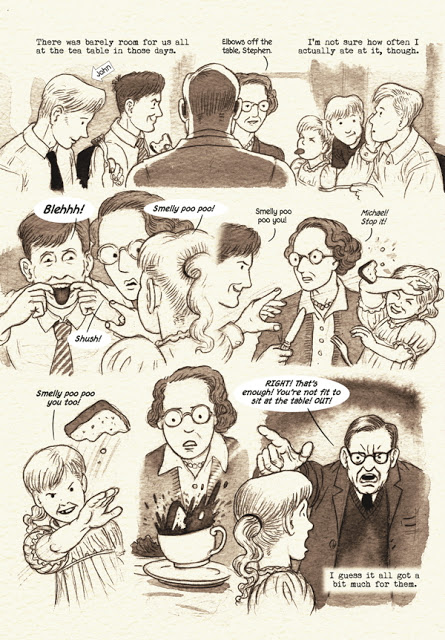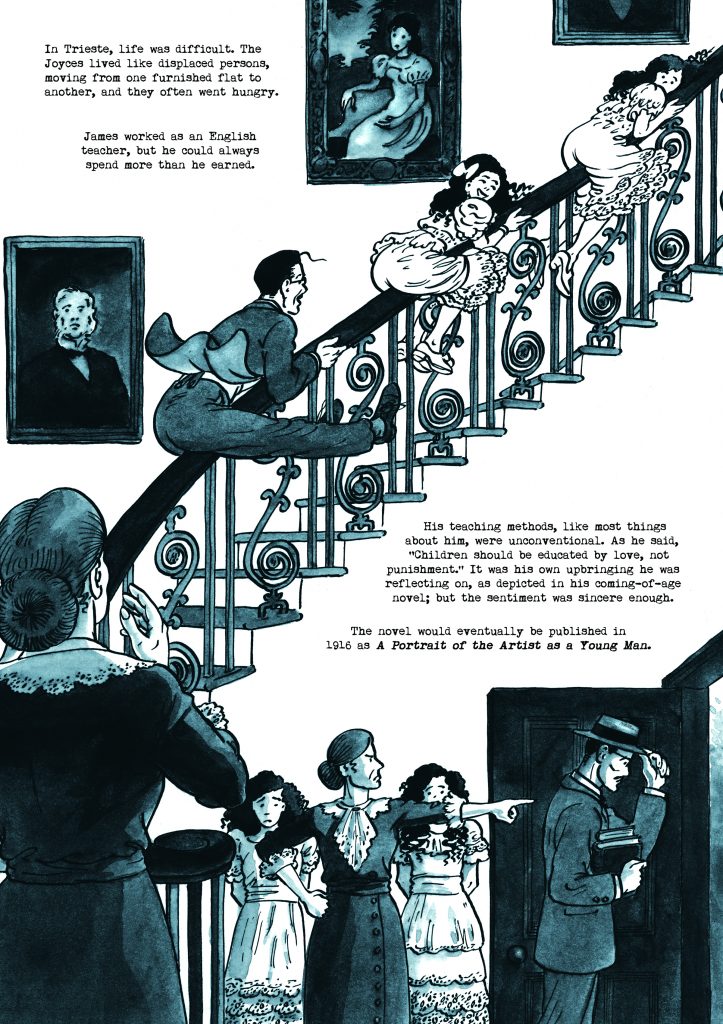 Dotter of Her Father’s Eyes
Dotter of Her Father’s Eyes
by Mary and Bryan Talbot
Publisher: Jonathan Cape
Out: Now
The Book: Part personal history, part biography, Dotter of Her Father’s Eyes contrasts two coming-of-age narratives: that of Lucia, the daughter of James Joyce, and that of author Mary Talbot, daughter of the eminent Joycean scholar James S. Atherton. Social expectations and gender politics, thwarted ambitions and personal tragedy are played out against two contrasting historical backgrounds, poignantly evoked by the atmospheric visual storytelling of award-winning graphic-novel pioneer Bryan Talbot.
Produced through an intense collaboration seldom seen between writers and artists, Dotter of Her Father’s Eyes is smart, funny, and sad – an essential addition to the evolving genre of graphic memoir.

The Review:
Father/daughter relationships can be fractious at best of times. Either the former is too protective of the latter, becoming inadvertently overbearing and prescriptive or, conversely, too immersed in work or personal projects and thus aloof and distant. It’s rare the father that can tread this tightrope successfully. It’s this relationship that Mary Talbot examines in her new graphic novel, Dotter of Her Father’s Eyes. Juxtaposing her own relationship with her father, James S. Atherton, a noted Joycean scholar, with that of James Joyce and his daughter Lucia, Talbot has created a bittersweet drama that will resonate with anyone who has a parent.
For a debut graphic novel, Mary’s writing is incredibly confident and assured. This may be partly due to her being an established, published scholar in her own right, and partly due to the fact that the book is drawn by her husband, Bryan, one of the UK’s most accomplished masters of the art. Bryan’s artwork mellifluously transports us up and down the timeline so effortlessly that we simply go with the flow. He very cleverly uses highly simplified, full-colour Julian Opie-like characters for the present day and Mary’s life story; a washed out sepia tone for Mary’s post-war childhood; and finally, a more rendered reality in a blue-wash to recount the tale of Lucia.
 Perhaps it is unsurprising that Mary’s academic career has focused on gender politics and power, once you have read this story. Being the only daughter with four elder brothers; a domineering father; the appalling repression and treatment meted out to women in the pre-Feminism era; and that she had two sons; all indicate a natural, and understandable, desire to readdress the balance somewhat. Yet despite the obviously painful, and joyful, recollections, and analysis of her relationship with her father, Mary never descends into mawkishness or hand-wringing self-pity, and remains refreshingly clear of the mire of the “misery memoir” that the book could so easily have become. Mary’s writing remains constantly engaging, and brings every character to vibrant, empathic life, as she contrasts her coming-of-age with that of Lucia’s. Where Mary’s father seems distant yet authoritarian, Joyce appears weaker, agreeing with his wife Nora’s more bombastic and conservative views on womanhood, as both girls are belittled for failing to live up to their parents’ expectations.
Perhaps it is unsurprising that Mary’s academic career has focused on gender politics and power, once you have read this story. Being the only daughter with four elder brothers; a domineering father; the appalling repression and treatment meted out to women in the pre-Feminism era; and that she had two sons; all indicate a natural, and understandable, desire to readdress the balance somewhat. Yet despite the obviously painful, and joyful, recollections, and analysis of her relationship with her father, Mary never descends into mawkishness or hand-wringing self-pity, and remains refreshingly clear of the mire of the “misery memoir” that the book could so easily have become. Mary’s writing remains constantly engaging, and brings every character to vibrant, empathic life, as she contrasts her coming-of-age with that of Lucia’s. Where Mary’s father seems distant yet authoritarian, Joyce appears weaker, agreeing with his wife Nora’s more bombastic and conservative views on womanhood, as both girls are belittled for failing to live up to their parents’ expectations.
Thankfully, Mary’s tale ends happier than the tragic Lucia’s, but both resonate long after the final page has been turned. This is destined to become a set text for graphic novel scholars.
I’ll confess my ignorance when it comes to Joyce, but this book sparked an interest in his life and writing and I started actively searching out further information, and no greater compliment can be paid than that. Fortunately there’s a comprehensive bibliography in the back.
Most fathers remain enigmas to their children, and it’s this attempt to understand her father’s motivations and moods—to get behind both his public and home personas, and in turn closure—that makes Mary’s writing so intriguing. Like the title’s pun suggests, Mary Talbot is wrapping up her father’s business, his memory and legacy. Dotting his eyes and crossing his tease.
• This review is cross-posted with permission from the Comic Book Alliance web site: the web site championing British comics and their creators
• More about Dotter of Her Father’s Eye’s on Mary Talbot’s official web site
Blogs/Interviews about the Book
More Reviews
“The Talbots continue the recent excellence in using the graphic novel as a tool to educate of important social issues. Although the issues are from a distant past, Dotter reminds us of the urgency in women’s issues and keeps the momentum moving along in the present and into the future.”
“There are some very deft little touches where she comments on her husband’s artwork – the fact her mother would have never worn a frilly apron; the way he doesn’t segregate the sexes in the classroom scenes. This is within the context of a wider awareness, from education to ballet lessons to obstetrics, on how women’s lives were directed into the ‘unnatural. There can’t be many more frightening and saddening moments in graphic novels than the account of the birth of a first child, and the terse note ‘without anaesthetic’.
The founder of downthetubes, which he established in 1998. John works as a comics and magazine editor, writer, and on promotional work for the Lakes International Comic Art Festival. He is currently editor of Star Trek Explorer, published by Titan – his third tour of duty on the title originally titled Star Trek Magazine.
Working in British comics publishing since the 1980s, his credits include editor of titles such as Doctor Who Magazine, Babylon 5 Magazine, and more. He also edited the comics anthology STRIP Magazine and edited several audio comics for ROK Comics. He has also edited several comic collections, including volumes of “Charley’s War” and “Dan Dare”.
He’s the writer of “Pilgrim: Secrets and Lies” for B7 Comics; “Crucible”, a creator-owned project with 2000AD artist Smuzz; and “Death Duty” and “Skow Dogs” with Dave Hailwood.
Categories: British Comics, downthetubes Comics News, downthetubes News, Reviews
 •
•  In Review: The Leopard from Lime Street – Birthright
In Review: The Leopard from Lime Street – Birthright  In Review: Psycho Gran Comic Capers Cavalcade by David Leach
In Review: Psycho Gran Comic Capers Cavalcade by David Leach  In Pictures and Review: Lawless 2024
In Pictures and Review: Lawless 2024  Shaman Kane storms back into action for an action-packed finale to latest adventure
Shaman Kane storms back into action for an action-packed finale to latest adventure